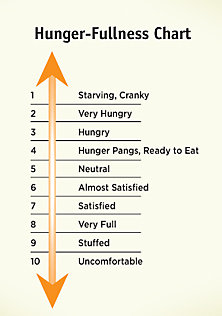- Fruits & Vegetables
- GMOs & Organics?
- Benefits of Grains
- What's a Carb?
- Low Carb Substitutes
- Proteins: Building Blocks
- Protein-Packed Breakfasts
- Meats: Keep it Lean
- Dairy Health Benefits
- Importance of Vitamin D
- Artificial Sweeteners
- Eating a Healthy Diet
- Fiber Sources & Benefits
- How Much Water?
- Example 2 Day Meal Plan
- Mediterranean Diet Pyramid
- Nutrition Facts Label
- Vitamins & Minerals
- U.S. Dietary Guidelines
hunger vs. craving
 |
Many people don't understand the difference between needing food and wanting food. This leads them to use food for more than fuel for their bodies and may lead to overeating. There are two types of hunger: physical hunger and psychological hunger. Physical or true hunger commonly causes an empty feeling in the stomach, stomach pangs, light headedness and sometimes headache and irritability. |
|
Psychological hunger (cravings) is often triggered by moods or emotions. Emotional triggers include eating in response to uncomfortable feelings (i.e., stress, loneliness and anger) or in response to more enjoyable feelings (i.e., happiness, celebration and excitement). Other non-hunger factors that may influence eating include the sight and smell of food, the taste of food, the pleasure of eating, social pressures or unconscious habits, such as eating while watching television or cooking. To be mindful is to be aware of what's occurring. Eating mindfully means paying attention to what and how much you're eating and why you're eating. The Hunger/Fullness Scale can be used to evaluate your physical hunger. You need to learn how your body tells you when you're truly hungry and appropriately full. When using the Hunger/Fullness Scale, the goal is to learn how to avoid getting to "Very Hungry" (2 or less) which can cause overeating and "Very Full" (8 or more). It takes time for our body to feel full, so you should stop eating when you're still a little bit hungry. If you stop while you're still a bit hungry, you will be surprised that 10 minutes later you will feel satisfied. Get in the habit of using the Hunger/Fullness scale when you begin thinking about eating and during your meals and snacks. It's helpful to gauge what your body is telling you before you make a decision about when to eat, what to eat and how much to eat.
Think Before You Eat |
|
H-E-B Health Care Services Notice of Privacy Practice | Texas State Board of Pharmacy | How to Dispose of Unused Medicines